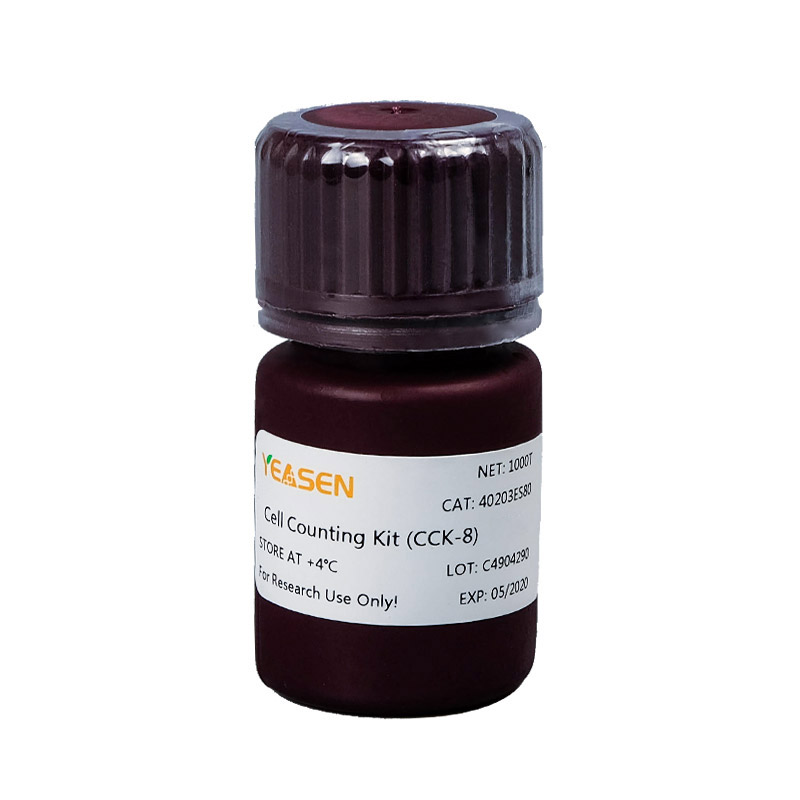Cell Counting Kit (CCK-8) CCK-8
Product Description
Cell Counting Kit-8 is a rapid and highly sensitive detection kit.
It based on WST-8 (chemical name: 2-(2-methoxy-4-nitrophenyl)-3-(4-nitrophenyl)-5-(2,4-disulfobenzene) -2h-tetrazole monosodium salt), widely used in cell proliferation and cytotoxicity. Wst-8, an upgrade of MTT, is reduced by mitochondrial dehydrogenase to water-soluble orange formazan product in the presence of electron-coupled reagents. The amount of the formazan dye generated by dehydrogenase in cells is directly proportional to the number of living cell and is measured by absorbance at 450 nm using a microplate reader.
CCK-8 method has a wide range application, such as drug screening, cell proliferation, cytotoxicity, tumor drug sensitivity test and activity detection of biological factors.
Advantages of CCK-8 method
Table 1 Comparison of advantages of CCK-8 method with other cell proliferation/toxicity detection methods
|
Detection method |
MTT method |
XTT method |
WST - 1 method |
CCK 8 method |
|---|---|---|---|---|
|
Water solubility of the formazan product |
Low (need to add organic solvent to dissolve and then test) |
High |
High |
High |
|
Product characteristics |
Powder |
2 bottles of solution |
Solution |
1 bottle of solution |
|
Method of use |
Mix into solution and use |
The solution was prepared just before use. |
Out of the box |
Out of the box |
|
Detection sensitivity |
High |
Very high |
Very high |
High |
|
Detection time |
Long |
Short |
Short |
The shortest |
|
Detection wavelength |
560-600 nm |
420-480 nm |
420-480 nm |
430-490 nm |
|
cytotoxicity |
High toxicity, complete disappearance of cell morphology |
Low toxicity, cell morphology unchanged |
Low toxicity, cell morphology unchanged |
Low toxicity, cell morphology unchanged |
|
Reagent stability |
General |
Low |
General |
High |
|
Bulk sample testing |
Feasible |
Appropriate |
Appropriate |
Appropriate |
Shipping and Storage
The components are shipped with ice pack and can be stored at -20°C for 1 year.
Cautions
1. It is recommended to use multi-channel pipette when conditions permit, which can reduce the difference between parallel holes.When adding CCK-8 reagent, it is recommended to add it diagonally against the culture board wall, not under the culture medium liquid level, which is easy to produce bubbles, which will interfere with OD reading.
2. Leukocytes may need to incubate for a long time.
3. When using standard 96-well plates, the minimum inoculation amount of adherent cells should be at least 1,000 cells/well (100 μL medium).
4. If a 450 nm filter is not available, a filter with an absorbance between 430 and 490 nm can be used, but a 450 nm filter has the highest detection sensitivity.
5. For research use only!
Instructions
1. Make standard curve (determine the specific number of cells)
1.Count the number of cells in the prepared cell suspension with the cell counting plate, and then inoculate the cells into the culture plate.
2. According to the proportion (e.g. 1/2 ratio) in turn with medium equal dilution into a cell concentration gradient, generally 3-5 cell concentration gradient, each concentration is recommended 3-6 repetitions.
3. After inoculation, cells were cultured for 2-4 hours to adhere to the wall, and then CCK-8 reagent was added to culture for a certain time to measure the OD value, and a standard curve with the number of cells as the X-axis and the OD value as the Y-axis was prepared. According to this standard curve, the number of cells in the unknown sample can be determined.
2. Cell activity detection
1. Inoculate cell suspension in 96-well plate (100 μL/ well). The culture plate was placed in an incubator for pre-culture for a period of time (37℃, 5% CO2).
2. Add 10 μL CCK-8 solution to each well (be careful not to form bubbles in the well, they will affect the OD reading).
3. Incubate the culture plate in the incubator for 1-4 hours.
3. Cell proliferation - toxicity test
1. Prepare 100 μL cell suspension in 96-well plate. The culture plate was placed in an incubator for pre-culture for 24 hours (37℃, 5% CO2).
2. Add 10 μL of the substance to be measured in different concentrations to the culture plate.
3. Incubate the culture plate in the incubator for an appropriate period of time (e.g. 6, 12, 24 or 48 h).
4. Add 10 μL CCK-8 solution to each well (be careful not to form bubbles in the well, they will affect the OD reading).
5. Incubate the culture plate in the incubator for 1-4 hours.
6. Determine the absorbance at 450 nm with a microplate reader.
7. If the OD value is not determined temporarily, add 10 μL 0.1M HCL solution or 1% W/V SDS solution to each well, cover the culture plate and store it at room temperature. The absorbance did not change when measured within 24 hours.
【Notes】 If the substance to be tested is oxidizing or reducing, replace the fresh medium before adding CCK-8 (remove the medium, wash the cells with the medium twice, then add the new medium) to remove the drug effect. Of course, when the drug influence is relatively small, the medium can be directly deducted from the blank absorption after the drug is added to the medium without changing the medium.
Dynamic calculation
Cell viability * (%) =[A(dosed) -A (blank)]/[A (0 dosed)-A (blank)] ×100.
A (dosing): Absorbance of pores with cells, CCK-8 solution, and drug solution.
A(blank): Absorbance of pores with medium and CCK-8 solution but without cells.
A (0 dosing): Absorbance of pores with cell, CCK-8 solution but no drug solution.
* Cell viability: cell proliferation activity or cytotoxic activity.
Catalog No.:*
Name*
phone Number:*
Lot:*
Email*
Country:*
Company/Institute:*

